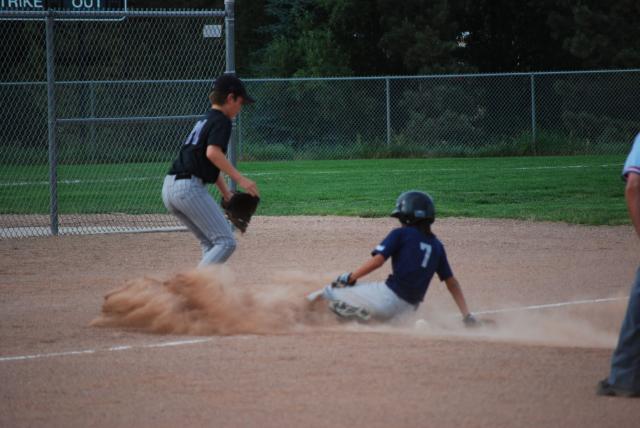During practices and games
- Make sure your child wears all required safety gear every time he or she plays and practices. Protective equipment is one of the most important factors in minimizing the risk of injury in baseball. According to a June 1996 study by the Consumer Product Safety Commission (CPSC), baseball protective equipment currently on the market may prevent, reduce, or lessen the severity of more than 58,000 injuries, or almost 36% of the estimated 162,100 baseball-related injuries requiring emergency-room treatment each year. Because most organized sports-related injuries (62%) occur during practices rather than games, your child needs to take the same safety precautions during practices as he does during games. Your child should wear the following:
- Helmet. A player should wear a properly fitted, certified helmet when batting, waiting to bat, and running the bases. Helmets should have eye protectors, either safety goggles or face guards made of clear plastic that attach to the sides of a batting helmet and covers the chin to the tip of the nose. These devices can help reduce the risk of a serious dental, facial or eye injury if a ball hits your child in the face. According to the CPSC, batting helmets with face guards may prevent, reduce, or lessen the severity of about 3,900 facial injuries suffered by batters in organized youth baseball.
- Protective eyewear. For kids who wear glasses, you should obtain protective eyewear from an eye-care professional who is aware of sports-safety standards, says Dr. Paul Vinger, a clinical professor of ophthalmology at Tufts Medical School in Boston and head of the Protective Eyewear Certification Council. Prescription glasses should be fitted with shatterproof lenses and sports frames that hold the lenses tightly in place.
- Catcher's gear. When catching, your child must always use a catcher's mitt and wear a helmet, face mask, throat guard, long-model chest protector, protective supporter, and shin guards.
- Shoes with molded cleats. Most youth leagues prohibit the use of shoes with steel spikes. Instead, wear molded, cleated baseball shoes. Make sure the shoes fit properly . Poorly fitted shoes, particularly those that allow movement side-to-side, are a major cause of injuries to the feet, knees, and ankles. Avoid hand-me downs, which are likely to fit poorly, and may have worn down cleats. Check the laces frequently for wear.
- Sunscreen: Apply an SPF level 15 sun screen on your child's face, neck and arms before your child goes outside and reapply if he is sweating.
- Clean uniform. Don't let your child leave his dirty uniform in his locker at school or on the floor of his room. Wearing unsanitary clothing poses a risk of staph infection, not only to your child but the rest of the team.
- Use softer-than-standard baseballs for younger players. Softer-than-standard balls may prevent, reduce, or lessen the severity of the 47,900 ball impact injuries to the head and neck, according to the CPSC. Be sure the ball is a softer, lighter baseball; softer, heavier baseballs do not, according to studies, reduce the risk of injuries.
- Replace standard, fixed bases with safety release bases. The CPSC estimates that the use of safety release bases may prevent, reduce, or lessen the severity of the 6,600 base-contact sliding injuries occurring in organized baseball. If your child's league hasn't switched to safety release bases, encourage it to do so.

- Do not conduct batting practice until everyone on the field is ready and paying attention. Especially with younger players, who are easily distracted, it is very important that, when they are in the field, they are paying attention to the batter at all times so they are prepared to field a ball hit in their direction.
- Make sure that players stand out of harms way. When your child's team is batting, they should stand or sit behind screens or fencing in front of the dugout and the on-deck circle should also be behind a screen so players don't get hit by wild pitches, foul balls, and flying bats. Also, make sure that equipment (bats, balls, helmets) is placed where players can't trip on it.
- Modify the rules for younger players. Leagues with players 10 years old and under should alter the rules of the game to include the use of adult pitchers or batting tees.
- Make sure players drink enough fluids. As parent or coach, you are responsible for taking precautions to prevent heat illnesses in exercising children and making sure they drink enough fluids
- Make sure your child's team/club/program has a weather policy. Guidelines regarding playing or practicing in bad weather, such as lightning storms or extreme heat should be established well in advance of the season, and followed by all coaches, players and spectators. In the event of lightning, teach your child to stay away from open fields, trees, and water and to get indoors or inside a car, if possible, until the storm passes, and, if caught out in the open, to lie down and curl up in a fetal position.








